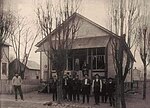Cedar Creek (Youghiogheny River tributary)
Allegheny PlateauPennsylvania river stubsRivers of PennsylvaniaRivers of Westmoreland County, PennsylvaniaTributaries of the Youghiogheny River ... and 1 more
Western Pennsylvania geography stubs
Cedar Creek is a 4.74 mi (7.63 km) long 2nd order tributary to the Youghiogheny River in Westmoreland County, Pennsylvania.
Excerpt from the Wikipedia article Cedar Creek (Youghiogheny River tributary) (License: CC BY-SA 3.0, Authors).Cedar Creek (Youghiogheny River tributary)
Great Allegheny Passage, Rostraver Township
Geographical coordinates (GPS) Address Nearby Places Show on map
Geographical coordinates (GPS)
| Latitude | Longitude |
|---|---|
| N 40.178888888889 ° | E -79.777777777778 ° |
Address
Great Allegheny Passage
15448 Rostraver Township
Pennsylvania, United States
Open on Google Maps









